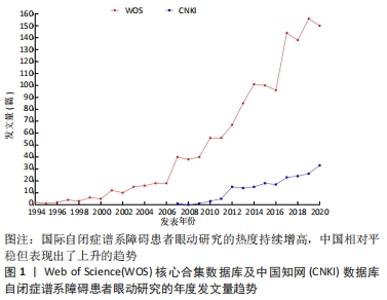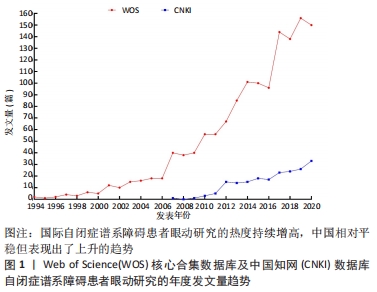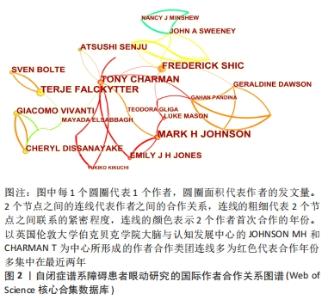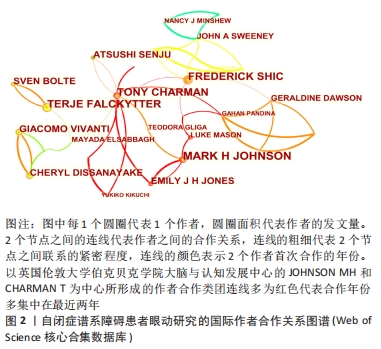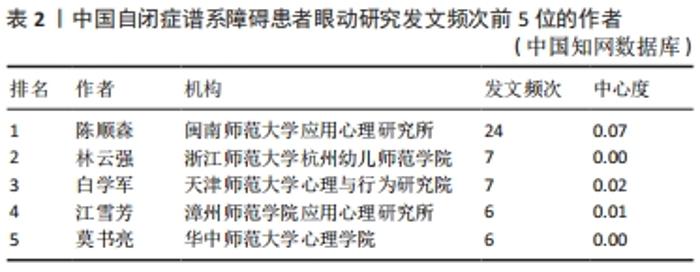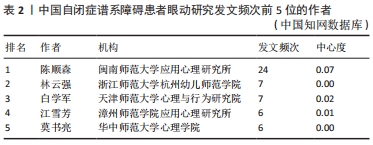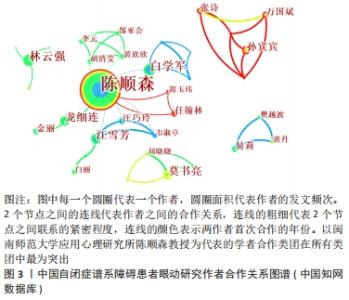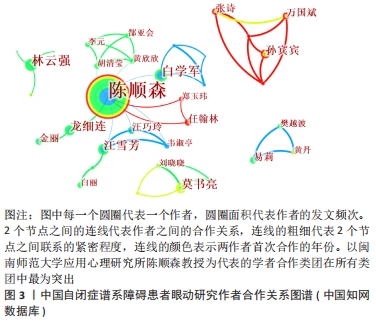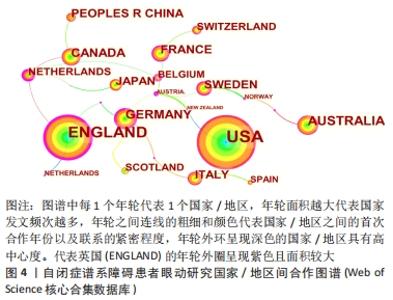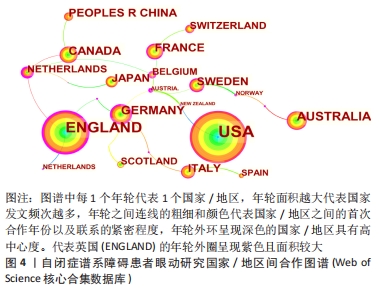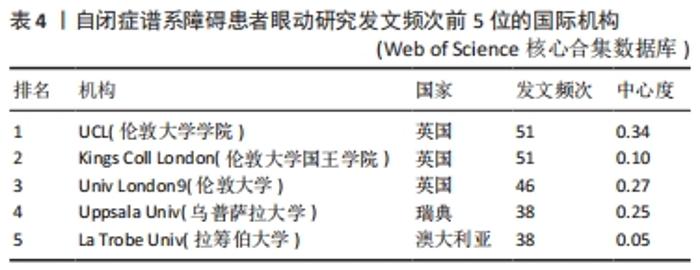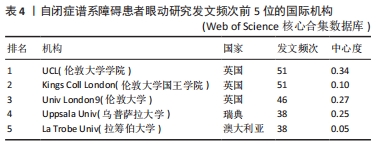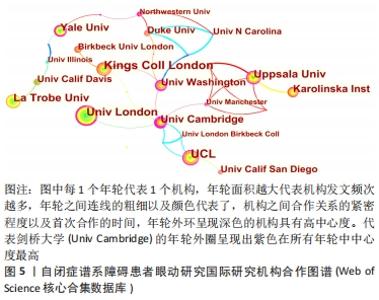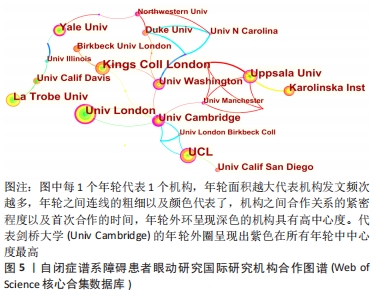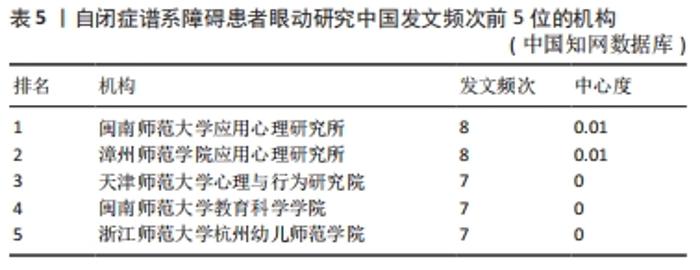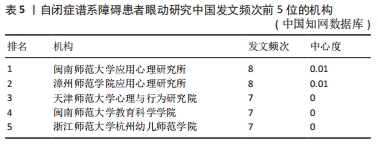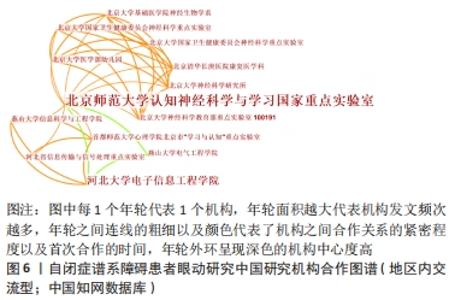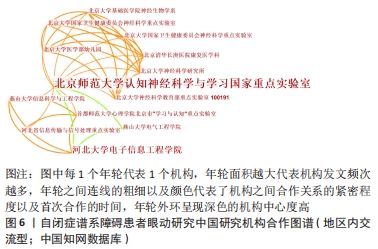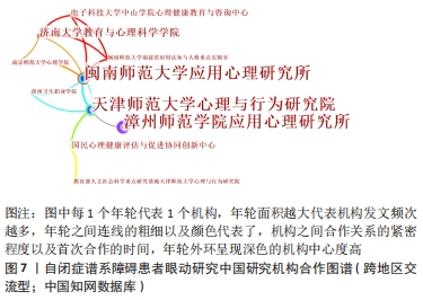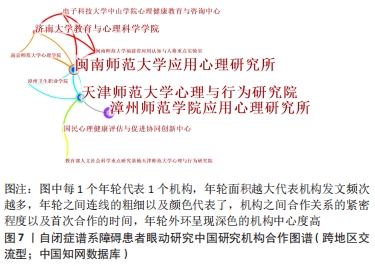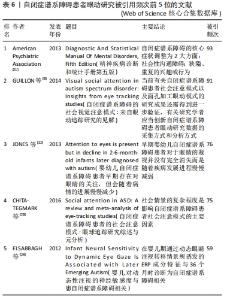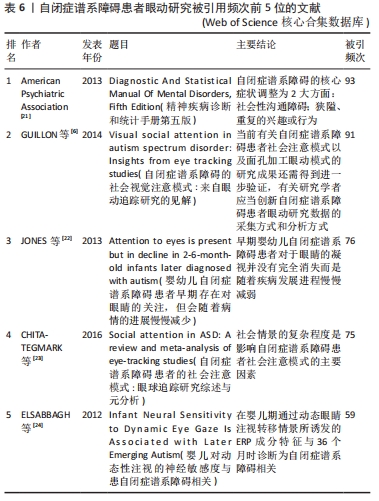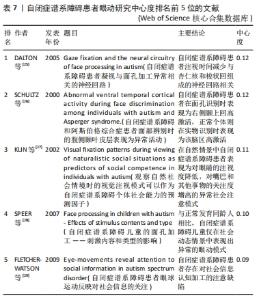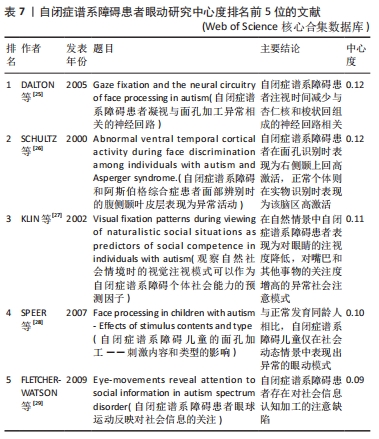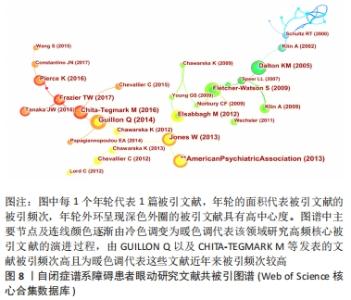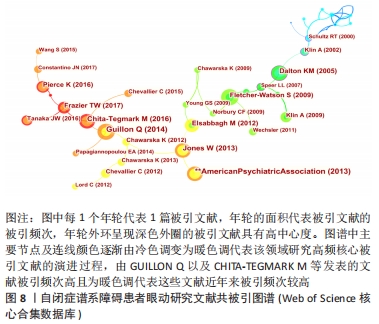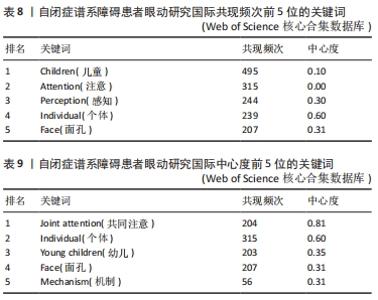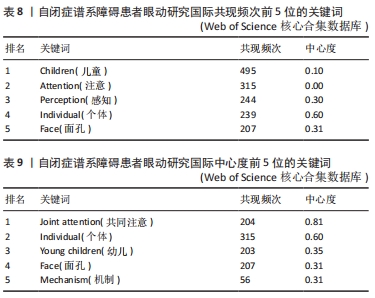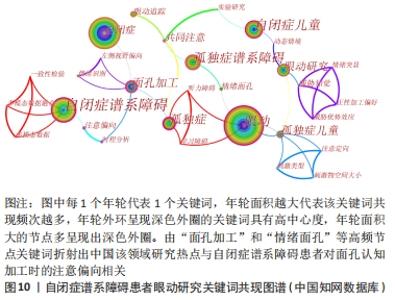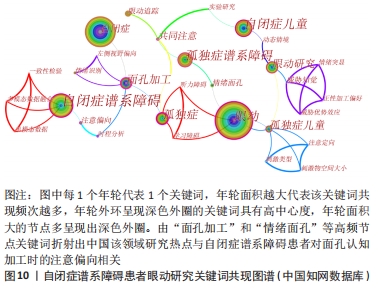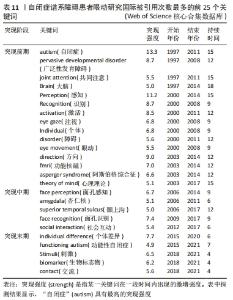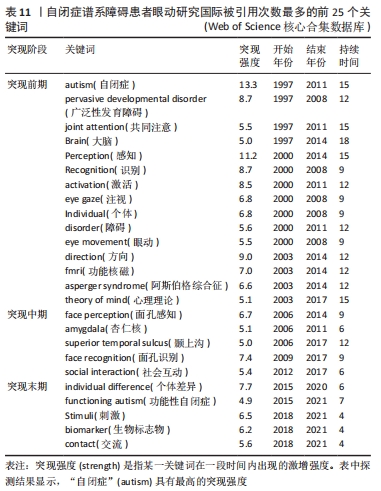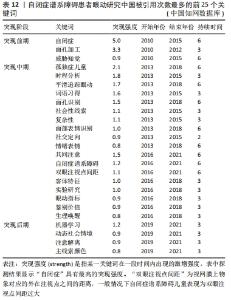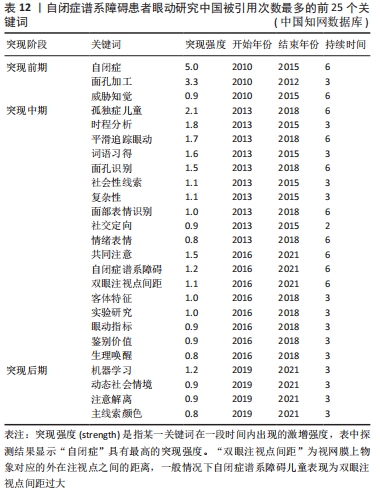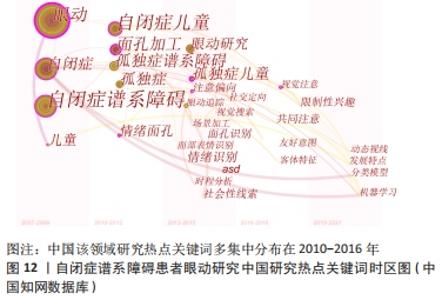Chinese Journal of Tissue Engineering Research ›› 2022, Vol. 26 ›› Issue (35): 5724-5732.doi: 10.12307/2022.938
Previous Articles Next Articles
Visualization analysis of literature on eye tracking in cognitive behaviors of autistic patients
She Jian1, Zhao Jing1, Zhang Jiaming1, Xia Haisha1, Zhong Dongling1, Li Yuxi1, Zheng Zhong2, Li Juan1, Jin Rongjiang1
- 1School of Health Preservation and Rehabilitation, Chengdu University of Traditional Chinese Medicine, Chengdu 610075, Sichuan Province, China; 2West China Hospital, Sichuan University, Chengdu 610044, Sichuan Province, China
-
Received:2022-01-04Accepted:2022-01-17Online:2022-12-18Published:2022-05-18 -
Contact:Jin Rongjiang, MD, Professor, Doctoral supervisor, School of Health Preservation and Rehabilitation, Chengdu University of Traditional Chinese Medicine, Chengdu 610075, Sichuan Province, China -
About author:She Jian, Master candidate, School of Health Preservation and Rehabilitation, Chengdu University of Traditional Chinese Medicine, Chengdu 610075, Sichuan Province, China -
Supported by:the National Natural Science Foundation of China, No. 81873354 (to ZZ); Sichuan Provincial Science and Technology Plan, No. 2020YFS0284 (to ZZ); the National Key Research and Development Program of China, No. 2019YFC1710302 (to JRJ)
CLC Number:
Cite this article
She Jian, Zhao Jing, Zhang Jiaming, Xia Haisha, Zhong Dongling, Li Yuxi, Zheng Zhong, Li Juan, Jin Rongjiang. Visualization analysis of literature on eye tracking in cognitive behaviors of autistic patients[J]. Chinese Journal of Tissue Engineering Research, 2022, 26(35): 5724-5732.
share this article
Add to citation manager EndNote|Reference Manager|ProCite|BibTeX|RefWorks
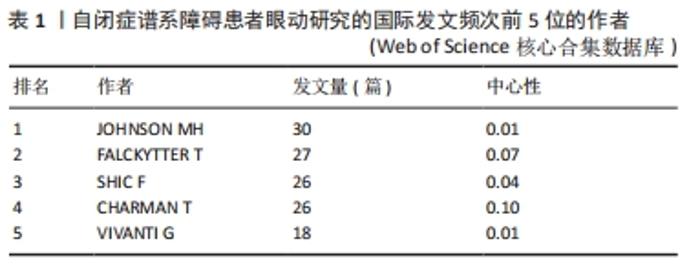
从结果来看Web of Science核心合集数据库中最早的文献发表于1994年,年发文趋势在2006-2007年和2016-2017年间出现了大幅度的增长,增长态势在2011-2014年维持时间最长。中国知网数据库中最早的文献发表于2007年,年发文量仅在2011年和最近两年间出现了较大的增幅。 2.2 作者合作网络分析 对来源于Web of Science核心合集数据库中的文献数据进行作者可视化分析,计量阈值选择(g-index per slice)=15,修剪选项(Pruning)选择寻径(Path Finder,PF)、修剪切片网络(Pruning sliced networks)、修剪合并网络(Pruning the merged network)进行国际作者合作网络分析,共得到322个节点,420条连线的图谱。结果显示从1994年至今共有15位作者发文频次大于10次,发文频次前5位的作者见表1。 "
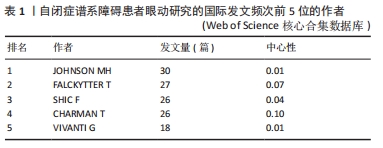
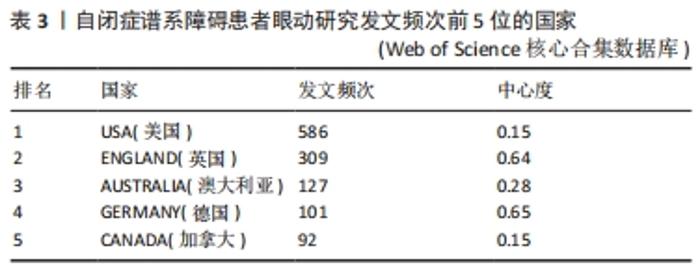
2.3 国家和研究机构合作网络分析 以国家为节点,对来源于Web of Science核心合集数据库中的文献数据进行可视化分析,计量阈值选择(Top N per slice)=25,修剪选项(Pruning)选择寻径(Path Finder,PF)、修剪切片网络(Pruning sliced networks)、修剪合并网络(Pruning the merged network)进行国家间合作网络分析,共得到48个节点,93条连线的图谱。结果显示发文频次大于50次的国家共有11个,美国发文频次最高,其次为英国,中国发文频次为73次排名第8位。发文频次前5位的国家见表3。整体上来看高中心度国家多集中在欧洲发达国家,英国是所有发文国家中发文频次相对较高且中心度相对较高的国家,提示当前该国家研究机构或作者在该领域的研究成果具有高影响力,见图4。"
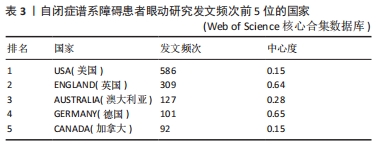
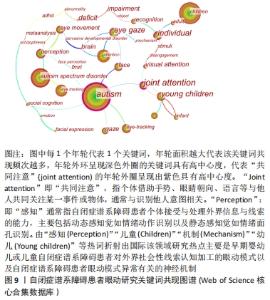
高被引频次文献多利用眼动研究婴幼儿或儿童自闭症谱系障碍个体的视觉注意模式,探究自闭症谱系障碍患者早期的可能预测因素,被引用频次最高的是“Diagnostic And Statistical Manual Of Mental Disorders,Fifth Edition”(美国精神障碍诊断和统计手册第五版),被引用频次为93次。高中心度文献多利用眼动技术研究自闭症谱系障碍患者的社会注意行为模式或结合脑影像学技术研究与自闭症谱系障碍患者视觉行为异常相关的神经机制,中心度最高的被引文献是Dalton KM等在2005年4月发表在《NATURE NEUROSCIENCE》上的“Gaze fixation and the neural circuitry of face processing in autism”(自闭症谱系障碍患者注视与面孔处理的神经回路),中心度为0.12。该项研究通过利用功能磁共振扫描与眼动记录仪相结合对自闭症谱系障碍患者开展研究,研究结果表明自闭症谱系障碍患者的凝视时间减少可能与杏仁核与边缘系统处理威胁性的社会和情感线索的过度激活有关,由于患者的凝视时间缩短导致了自闭症谱系障碍患者的梭状回表现出低激活。 2.5 关键词分析结果 2.5.1 关键词共现分析结果 关键词往往是对文章内容的高度凝练表达,在某领域中某个关键词共现频次以及中心性越高,这个关键词就越能代表该领域的研究热点[30]。 以关键词为节点,对来源于Web of Science核心合集数据库中的文献数据进行可视化分析,计量阈值选择(Top N% per slice)=7%,修剪选项(Pruning)选择寻径(Path Finder,PF)、修剪切片网络(Pruning sliced networks)、修剪合并网络(Pruning the merged network)进行英文文献关键词共现网络分析,共得到151个节点,429条连线的图谱,见图9。 "
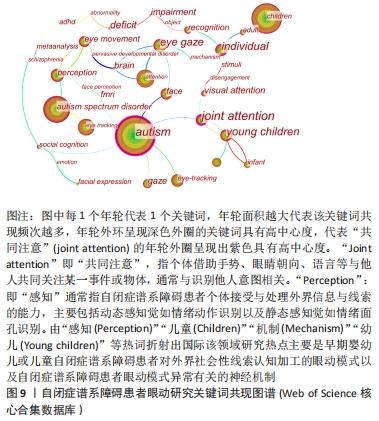
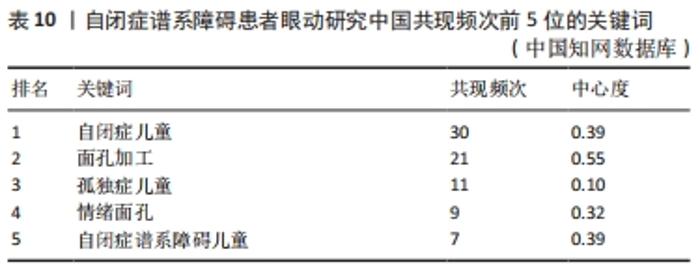
以关键词为节点,对来源于中国知网数据库中的文献数据进行可视化分析,计量阈值选择(g-index per slice)=25,修剪选项(Pruning)选择寻径(Path Finder,PF)、修剪切片网络(Pruning sliced networks)、修剪合并网络(Pruning the merged network)进行中文文献关键词共现网络分析,共得到167个节点,249条连线的图谱。除去与检索策略有关的关键词,共现频次前5位的关键词见表10。高频次关键词与高中心度关键词基本保持一致,见图10,高频次与高中心度关键词提示在中国该领域整个研究进程中研究者多利用眼动技术研究儿童自闭症谱系障碍患者对于面孔特征认知加工的眼动模式或对于不同情绪面孔如正性情绪面孔、负性情绪面孔以及中性情绪面孔的注意偏向。 "
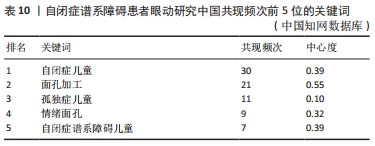
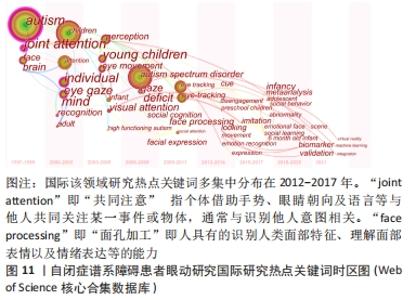
关键词突发性探测是通过对某一段时间内激增的关键词进行探测,以揭示该段时间段内的研究热点,同时通过探测结果也可以预测哪些热点关键词能够在未来延续爆发性趋势,成为未来该领域的潜在研究热点[31]。英文文献关键词探测结果显示国际该领域最早出现的突现词共有4个分别是“自闭症(autism)、广泛性发育障碍(pervasive developmental disorder)、共同注意(joint attention)、大脑(brain)”,首次突现时间均为1997年,早期突现词表明,国际早期该领域研究初期多与自闭症谱系障碍患者大脑神经机制以及共同注意模式相关。当前仍在持续的突现词为4个,分别为“生物标志物(biomarker)、刺激(stimuli)、交流(contact)、功能性自闭症(functioning autism)”,末期突现词表明当前国际该领域研究后期多与个体自然背景下自闭症谱系障碍患者处理社会性刺激线索的眼动模式以及生物标志物相关。持续时间最长的突现词仅有1个为“大脑(brain)”,持续时间从1997-2014年共持续了18年。 中文文献关键词探测结果显示中国该领域最早出现的突现词共有3个:分别是“面孔加工、自闭症、威胁知觉”,首次突现时间均为2010年,早期突现词表明中国该领域研究初期多与自闭症谱系障碍患者处理社会威胁性线索如负性情绪面孔相关。持续至今的突现词有“动态社会情景”和“机器学习”等,末期突现词表明中国该领域研究后期多与自闭症谱系障碍患者眼动研究数据的生态效度以及机器学习等数据分析方法相关,与国际该领域研究方向基本一致。中国无爆发持续时间突出的突现词。 2.5.3 关键词时间演化分析结果 关键词时区视图侧重于从时间维度上来表示研究热点的整体演进情况,同时能够清晰地展示各研究热点关键词之间的联系,动态反映该领域研究热点和前沿信息的变化趋势[10,16]。文章在关键词共现网络分析的基础上,运用CiteSpace软件分别对英文文献关键词以及中文文献关键词进行时间演化分析,见图11,12。 "
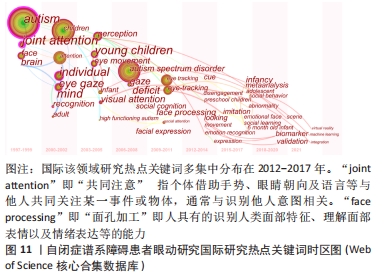

由国际研究热点关键词时区图可以看出,国际自闭症谱系障碍患者的眼动研究开始出现在1997-1999年。从共现关键词的时间分布来看,国际该领域研究热点关键词多集中出现在2012-2017年,表明在这6年间国际该领域研究成果颇丰,与国际年发文量持续增长时间节点基本保持一致,研究成果主要与“情绪识别(emotion recongnition)”以及“婴儿自闭症谱系障碍患者(infancy)”等有关。近年来国际该领域的研究主要与“机器学习(machine learning)、VR眼动仪(virtual reality)、生物标志物(biomarker)”有关。由中国研究热点关键词时区图可以看出,自闭症谱系障碍患者的眼动研究多开始出现在2010-2012年。中国研究成果主要集中出现在2010-2016年,整个研究进程的研究对象多为儿童及青少年自闭症谱系障碍患者,对于婴幼儿自闭症谱系障碍患者的眼动研究相对较少。近几年中国研究中同样出现了机器学习这一数据分析手段,利用机器学习可以实现对于研究数据的特征值提取[32]。由中国与国际热点词的时间分布图谱折射出未来中国与国际的研究热点主要是利用机器学习等先进技术提取对自闭症谱系障碍患者有关研究数据的特征值以及提高研究数据的生态效度寻找可能的生物标志物相关。 "

| [1] 王薇,徐知宇,李永鑫,等.情绪主题绘本阅读对自闭症谱系障碍儿童情绪理解障碍的干预效果[J].心理发展与教育,2019,35(5): 566-572. [2] 段云峰,吴晓丽,金锋.自闭症的病因和治疗方法研究进展[J].中国科学:生命科学,2015,45(9):820-844. [3] 贺超颖,陈靓影,张坤.眼部线索对孤独症儿童视线加工的影响[J].中国特殊教育,2019,228(6):47-55. [4] 陈顺森,白学军,张日昇.自闭症谱系障碍的症状、诊断与干预[J].心理科学进展,2011,19(1):60-72. [5] 张名魁,孙复川.高抗干扰性的红外光电反射眼动测量仪[J].生物医学工程学杂志,1989,6(4):282-286. [6] GUILLON Q, HADJIKHANI N, BADUEL S, et al. Visual social attention in autism spectrum disorder: insights from eye tracking studies. Neurosci Biobehav Rev. 2014;42:279-297. [7] 郝艳斌,王福兴,谢和平,等.自闭症谱系障碍者的面孔加工特点——眼动研究的元分析[J].心理科学进展,2018,26(1):26-41. [8] 侯婷婷,陈潇,李开云,等.自闭症个体的面孔识别障碍:来自眼动和神经科学技术的证据[J].中国特殊教育,2020(11):42-48. [9] 王广帅,陈靓影,张坤.基于多重因素混合设计和眼动追踪的自闭症谱系障碍儿童情绪面孔识别[J].科学通报,2018,63(31):3204-3216. [10] 陈悦,陈超美,刘则渊,等.CiteSpace知识图谱的方法论功能[J].科学学研究,2015,33(2):242-253. [11] 侯剑华,胡志刚.CiteSpace软件应用研究的回顾与展望[J].现代情报,2013,33(4):99-103. [12] 兰芹.近十年国际自闭症干预研究热点与前沿分析[J].郑州师范教育,2021,10(3):8-14. [13] 周晓雯.近十年国外自闭症谱系障碍共同注意力研究的热点与趋势——基于Web of Science核心合集数据库的CiteSpace分析[J].海南师范大学学报(社会科学版),2020,33(1):104-109. [14] 刘静.眼动技术在自闭症研究中应用的文献综述[J].心理学进展, 2020,10(5):552-558. [15] 范晓壮,毕小彬,谢宇,等.高功能自闭症个体对威胁性情绪面孔的注意偏向[J].心理科学进展,2020,28(7):1172-1186. [16] 李田,魏亚威,马利.基于CiteSpace的我国中医“治未病”文献知识图谱分析[J].中国中医基础医学杂志,2018,24(11):1526-1529. [17] 高东平,戴阿咪,杜然然,等.基于文献计量学的抑郁症与肠道菌群关联性研究[J].中国医药导报,2017,14(14):173-176. [18] 李程,何静,白羽,等.我国近10年艾灸护理的CiteSpace知识图谱可视化分析[J].护理研究,2019,33(8):1309-1312. [19] 张玢,李海燕,刘晓婷,等.生药学分子水平研究的国际发展态势分析[J].中国中药杂志,2016,41(3):410-415. [20] 梁玉丹,王小寅,罗海丽,等.CiteSpace应用对Web of Science近5年针灸相关文献的计量学及可视化分析[J].中华中医药杂志, 2017,32(5):2163-2168. [21] American Psychiatric Association. Diagnostic and Statistical Manual of Mental Disorders, Fifth Edition. Arlington VA: American Psychiatric Press. 2013:50-58. [22] JONES W, KLIN A. Attention to eyes is present but in decline in 2-6-month-old infants later diagnosed with autism. Nature. 2013; 504(7480):427-431. [23] CHITA-TEGMARK M. Social attention in ASD: a review and meta-analysis of eye-tracking studies. Res Dev Disabil. 2016;48:79-83. [24] ELSABBAGH M, MERCURE E, HUDRY K, et al. Infant Neural Sensitivity to Dynamic Eye Gaze Is Associated with Later Emerging Autism. Curr Biol. 2012;22(4):338-342. [25] DALTON KM, NACEWICZ BM, JOHNSTONE T, et al. Gaze fixation and the neural circuitry of face processing in autism. Nat Neurosci. 2005;8(4): 519-526. [26] SCHULTZ RT, GAUTHIER I, KLIN A, et al. Abnormal ventral temporal cortical activity during face discrimination among individuals with autism and Asperger syndrome. Arch Gen Psychiatry. 2000;57(4):331-340. [27] KLIN A, JONES W, SCHULTZ R, et al. Visual fixation patterns during viewing of naturalistic social situations as predictors of social competence in individuals with autism. Arch Gen Psychiatry. 2002;59(9):809-816. [28] SPEER LL, COOK AE, MCMAHON WM, et al. Face processing in children with autism - Effects of stimulus contents and type. Autism. 2007;11(3): 265-277. [29] FLETCHER-WATSON S, LEEKAM SR, BENSON V, et al. Eye-movements reveal attention to social information in autism spectrum disorder. Neuropsychologia. 2009;47(1):248-257. [30] 何晓萍,黄龙.大数据领域演进路径、研究热点与前沿的可视化分析[J].现代情报,2015,35(4):46-51. [31] 胡佳卉,孟庆刚.基于CiteSpace的中药治疗2型糖尿病知识图谱分析[J].中华中医药杂志,2017,32(9):4102-4106. [32] FERNANDEZ ROJAS R, HUANG X, OU KL. A machine learning approach for the identification of a biomarker of human pain using fNIRS. Sci Rep. 2019;9(1):5645. [33] 高世欢,陈顺森,苏彦捷,等.视觉正常的自闭症儿童双眼注视点间距的特点及其意义[J].心理学报,2019,51(9):1018-1027. [34] 任翰林,黄亮,郑玉玮,等.自闭症谱系障碍儿童的肢体情绪加工特征:来自眼动的证据[J].中国临床心理学杂志,2021,29(1):8-13. [35] BEDFORD R, ELSABBAGH M, GLIGA T, et al. Precursors to social and communication difficulties in infants at-risk for autism: gaze following and attentional engagement. J Autism Dev Disord. 2012;42(10):2208-2218. [36] GLIGA T, BEDFORD R, CHARMAN T, et al. Enhanced visual search in infancy predicts emerging autism symptoms. Curr Biol. 2015;25(13):1727-1730. [37] JOSEPH RM, KEEHN B, CONNOLLY C, et al. Why is visual search superior in autism spectrum disorder? Dev Sci. 2009;12(6):1083-1096. [38] 伏干.眼动研究在特殊教育中的应用:基于阅读障碍眼动研究的分析[J].心理与行为研究,2014,12(1):136-143. [39] 许晓雯,肖永涛.眼动技术在我国特殊儿童中的应用研究[J].中国听力语言康复科学杂志,2021,19(4):314-319. [40] DRAVIDA S, NOAH JA, ZHANG X, et al. Joint attention during live person-to-person contact activates rtpj, including a sub-component associated with spontaneous eye-to-eye contact. Front Hum Neurosci. 2020;14:201. [41] DAKIN S, FRITH U. Vagaries of visual perception in autism. Neuron. 2005;48(3):497-507. [42] PIERCE K, MARINERO S, HAZIN R, et al. Eye tracking reveals abnormal visual preference for geometric images as an early biomarker of an autism spectrum disorder subtype associated with increased symptom severity. Biol Psychiatry. 2016;79(8):657-666. |
| [1] | Li Kun, Gao Erke, Xiong Feng, Wang Xing, Wu Danqi, Li Zhijun, Zhang Shaojie, Liu Yanan, Duo Lan, Li Ziyu. Feasibility of axial transpedicle screw internal fixation in children aged 1 to 6 years [J]. Chinese Journal of Tissue Engineering Research, 2022, 26(9): 1383-1387. |
| [2] | Li Zhiyi, He Pengcheng, Bian Tianyue, Xiao Yuxia, Gao Lu, Liu Huasheng. Bibliometric and visualized analysis of ferroptosis mechanism research [J]. Chinese Journal of Tissue Engineering Research, 2022, 26(8): 1202-1209. |
| [3] | Zhao Jing, Liu Xiaobo, Zhang Yue, Zhang Jiaming, Zhong Dongling, Li Juan, Jin Rongjiang. Visualization analysis of neuromuscular electrical stimulation therapy based on CiteSpace: therapeutic effects, hot spots, and developmental trends [J]. Chinese Journal of Tissue Engineering Research, 2022, 26(8): 1234-1241. |
| [4] | Song Yan, Zheng Kun, Wei Haoxin, Lu Dezhi, Xu Yuanjing, Wang Xiaowen, Wang Jinwu. reliability of flat feet evaluated by foot posture index and its application in three-dimensional printing insoles [J]. Chinese Journal of Tissue Engineering Research, 2022, 26(3): 344-349. |
| [5] | He Qize, Meng Lin, Wang Jie, Weng Chenyi. Citespace-based visual analysis of research literature related to cartilage repair using cartilage precursor cells [J]. Chinese Journal of Tissue Engineering Research, 2022, 26(29): 4723-4728. |
| [6] | Li Zhishuai, Zhang Hongqian, Liu Jianquan, Zhang Hankun, Li Li. Visualization analysis of current research hotspots on rehabilitation treatment after anterior cruciate ligament reconstruction [J]. Chinese Journal of Tissue Engineering Research, 2022, 26(26): 4234-4241. |
| [7] | Dong Jiale, Wei Yuanhao, Zhang Hongwu. Visualization analysis of bone defect treatment based on knowledge map [J]. Chinese Journal of Tissue Engineering Research, 2022, 26(18): 2906-2913. |
| [8] | Chen Xianxiang, Liao Shijie, Li Boxiang, Li Chong, Huang Qian, Lin Chengsen, Liu Yun, Lu Rongbin, Ding Xiaofei. Characteristics and application on animal models of different species of Perthes disease [J]. Chinese Journal of Tissue Engineering Research, 2022, 26(18): 2922-2929. |
| [9] | Chen Keyi, Wang Dingxuan, Zhao Sike, Xia Zhangrong. Research hotspots of pressure training in rehabilitation and visualized analysis of relevant literature data in the past 10 years [J]. Chinese Journal of Tissue Engineering Research, 2022, 26(15): 2406-2411. |
| [10] | Li Zhishuai, Zhang Hongqian, Li Li, Han Xinwen, Feng Jing. Finite element analysis of the knee joint: research hotspots and trends [J]. Chinese Journal of Tissue Engineering Research, 2022, 26(15): 2412-2418. |
| [11] | Xue Xiali, Deng Zhongyi, Sun Junzhi, Li Ning, Ren Wenbo, Zhou Ling, He Ye. Hot spots and frontiers of rehabilitation robot research in recent 10 years: a bibliometric analysis based on the Web of Science database [J]. Chinese Journal of Tissue Engineering Research, 2022, 26(14): 2214-2222. |
| [12] | Wang Susu, Li Lifeng, Zhang Yimin. Visualization analysis on research progress and hotspots of exercise therapy for sarcopenia in older adults in recent decade [J]. Chinese Journal of Tissue Engineering Research, 2022, 26(14): 2223-2230. |
| [13] | Li Kun, Wang Xing, Li Zhijun, Gao Shang, Sun Hao, Xiong Feng, Wang Peng . Three-dimensional finite element analysis of anterior cervical fixation system in children [J]. Chinese Journal of Tissue Engineering Research, 2022, 26(12): 1866-1871. |
| [14] | Xu Jie, Zhou Wenqi, Luo Xiaobing. Visual analysis of patellofemoral pain syndrome research hotspots and content [J]. Chinese Journal of Tissue Engineering Research, 2022, 26(12): 1877-1887. |
| [15] | Wang Mengting, Gu Yanping, Ren Wenbo, Qin Qian, Bai Bingyi, Liao Yuanpeng. Research hotspots of blood flow restriction training for dyskinesia based on visualization analysis [J]. Chinese Journal of Tissue Engineering Research, 2021, 25(8): 1264-1269. |
| Viewed | ||||||
|
Full text |
|
|||||
|
Abstract |
|
|||||
